I think my job is really cool. I really do. I get to treat people of all ages and abilities. I get to see people return to doing what they love pain free. I also get to be a trusted resource to help guide people through some of their best and worst times. But there is something really special when a woman trusts me to assist in her prenatal care. Having recently been on the other end of things, I know what an emotional, vulnerable, incredible, exhausting and exciting journey pregnancy is, and I find it really freaking cool that I get to be a small part of so many family stories. I hope that if you/a friend/a loved one are on that journey today, or maybe one day, that you can take even just one piece of information from this post that may help them in some way. I really enjoyed writing this one, so I hope you enjoy reading it.
Pregnancy – The Ultimate Athletic Event
The physiologic adaptations that the female body makes throughout pregnancy is no simple feat. On average, labor begins 41 weeks and one day after conception and the body hits the ground running from the start.
First Trimester Changes
- The body immediately increases heart volume by 15-20% and blood volume/cardiac output by 40%.
- Hormones start pumping to increase respiratory rate and get more oxygen to the baby.
- Food aversions kick in while fatigue, sweating, nausea and dizziness may all start making appearances.
- The initial 13 weeks consist of the body establishing new networks and physiologic channels for mom and baby to connect.
Second Trimester Changes
The second trimester tends to mark the beginning of physical discomforts and therefore is when many of my patients start receiving care. As the belly begins to grow, the lumbar spine, pelvis and hips bear new stresses. The center of gravity shifts and the body must accommodate its new positioning. The low back vertebrae are designed to bear the load during pregnancy, which is the most frequent complaint that I hear from my preggo’s.
Third Trimester Changes
As relaxin levels continue to rise into the third trimester, I often hear of “random” aches and pains. Sometimes, the elbows begin to hurt. Occasionally, old knee injuries that haven’t been an issue for 10 years suddenly reemerge. The body is preparing for birth by relaxing ligaments and tendons which, combined with the increase in weight, can cause some real discomfort.
These are all things that chiropractic care can help alleviate. I have treated many patients weekly throughout the course of their pregnancy and we often used the term “patch things up”. This is because each week they tend to be feeling new or different discomforts. We treat whatever the body is feeling in that moment, and then adapt to whatever the next week brings.
Is it safe to See a Chiropractor during Pregnancy?
Throughout the course of my pregnancy, I spent a lot of time on google. I googled everything. “Sneezing a lot during week 20”. “Numb ring finger during week 29”. “Is it normal to be eating cake at 3am when 39 weeks pregnant”. It is natural to question everything we do because we are no longer just thinking about ourselves.
The same goes for receiving care throughout pregnancy. Is this safe? Is this the best option for me right now? All fair questions. As always, it is important to ask your OB or midwives about any concerns you may have. However, we do know that chiropractic care is proven to be safe (and incredibly effective) throughout pregnancy.

What to Expect From Chiropractic Care during Pregnancy
Care will not, and should not, be the same throughout the duration of a pregnancy. As the body adapts, so does treatment.
Early Prenatal Care
- Early prenatal care is typically a combination of manual therapy, manipulation and full-body exercises.
- We begin talking about breathing and core stability.
- Exercises will be adjusted to eliminate excessive lumbar flexion such as sit ups and toes to bar.
Second Semester Care
Mid-pregnancy care begins to shift to more manual therapy as the belly really pops. I typically don’t adjust the lumbar spine around this time. Personal choice. There are plenty of docs who do. Having traveled this path, I found ~week 20 to be a very vulnerable time period for me. Things were changing daily, the belly was really growing and I was beginning to feel flutters of movement. I found that muscle work, core stabilizing exercises and intentional movement felt best to me at this time and I carry that sentiment over to how I treat my patients.
Third Trimester Care
Care towards the end of pregnancy is much like a game of whack-a-mole.
- This is when we begin to really see musculoskeletal asymmetries popping up and feelings of discomfort tend to increase.
- Treatment is loaded with hands-on therapy, breath work and altering of exercise prescriptions.
- We focus a lot on single arm and single leg movements, carries, core exercises and simple stretches.
Care is incredibly intentional at this point. Every aspect of a treatment session has a purpose and a goal. If your chiropractic care is looking the same week to week throughout your pregnancy, I recommend looking elsewhere. If you ask your chiropractor the WHY behind what they are doing and they cannot answer, I recommend looking elsewhere. Just like any medical professional, chiropractors often have specialties. This is a period in your life that I highly recommend seeking out those who are specialized in what you need.
How to Choose the Best Prenatal Chiropractor
Additionally, there are certain qualifications I recommend you look for when selecting your chiropractor.
- Check and see if the chiropractor has any specific training in prenatal care. Some well known certifications are Webster, DNS or Birthfit.
- A chiropractor who is seasoned in treatment of pregnant and postpartum women will likely have a network of other professionals to connect you to as well. I personally have local acupuncturists, personal trainers, massage therapists, nutritionists and pelvic floor physical therapists whose business cards I am frequently handing out.
- If you are having trouble finding someone local who is qualified, ask your other practitioners if they have any recommendations. Not only does it take a village to raise a child, but it takes one to help mom have a healthy, safe and comfortable pregnancy as well.

What are the benefits of seeing a chiropractor during pregnancy?
Let’s get into the meat and potatoes. Why should a chiropractor play a role in prenatal care?
1.Make Mama More Comfortable!
As we talked about above, the female body goes through a plethora of changes in the course of 40(ish) weeks. The weight gain and constant hormone fluctuations can really cause the perfect storm of physical and emotional stresses. Chiropractic care can relieve discomforts and overall facilitate a more comfortable pregnancy. This cannot be stressed enough. Happy and healthy mom = happy and healthy baby!
2. Get Strong for Labor
When someone is preparing for an orthopedic surgery, we often use the term prehab. We strengthen and prepare the joint, as well as those above and below it, in an effort to improve the post-surgical outcome. Stronger going in = stronger coming out. The same concept applies to prenatal care. The stronger you are going into labor, the quicker the recovery will be on the postpartum side. A crucial component of prenatal care is breath work, core stability training and exercise prescriptions to help support the body during this time. Labor is a wild and unpredictable process, but I have yet to hear anyone say they were TOO strong to give birth.
3. Improves Positioning of Baby
As the baby and belly grow in size, women tend to experience some asymmetries. In my world, these often present as “my left lower back is killing me!” Or “ I feel like she is sitting on my right hip!” While these aches are totally normal, there is no need to suffer through. With manual therapy, adjustments (I used to crave having my hip adjusted, no lie) and exercises to help support treatment, we can make mom more comfortable while also providing the baby with more space to thrive. The Webster Technique teaches manipulations designed to decrease potential constraints in the uterus and help position baby in the optimal position for birth. Position is key!
4. Shorter and less complicated labors
Fun fact: The nerves that control the uterus are located in the lumbar spine. What exactly does this mean? Any interferences with these nerves can affect the ability of the uterus to optimally perform its job. Think about the classic water hose example. If you are watering your flowers (uterus? Stick with me) and I put my heel on the hose, your flowers (uterus again) will be receiving less water. Less water= flowers (you know the drill now) not performing as well as they could be. If the lower back is in pain, everything is tense. Tension slows labor. Adjustments relieve pain and tension. Research has shown us that regular chiropractic care can lead to a shorter labor.
5. Maintain Ranges of Motion
One thing that I was not prepared for entering motherhood was how many uncomfortable positions I would find myself in. Kneeling down with a baby to pick up a dropped burp cloth. Sitting on the floor playing for prolonged periods of time. Holding a baby who finally fell asleep upright in a chair while trying to not wake her. Each prenatal treatment I provide, I am working to maintain ranges of motion. We do a ton of hip mobility work, since they tend to bear most of the stresses. However, everyone tends to forget about the upper body. The neck and shoulders take a big hit during pregnancy as the center of gravity shifts. Maintaining the ranges of motion with regular treatments improves the body’s ability to complete the tasks you ask of it later on.

Recommendations for Expecting Moms from a Chiropractor and a Mom
As I write this article, my 7-month old daughter sleeps in the room next to me. I think I have a loaf of bread that has been in my pantry longer than I have been a mom, so I feel silly providing any advice as if I am old and wise. However, having treated my fair share of patients (and friends) throughout this season of their life, I do have some things to share.
- First and foremost, ask for help. Pregnancy is bound to throw new aches, pains, heartburns and anxieties your way, but I promise there are things we can do to help. I have taught husbands how to put Kinesiotape on backs and bellies to help relieve pain. I have taught MIL’s to put cupping sets on quads and how to safely stretch hamstrings. I have invented bizarre stretches to fix numb hands in the middle of the night and tweaked breakfast routines to help with heartburn. There is no reason to fight through aches and pains when there is help to be had…. Which brings me to my next piece of advice.
- Use the resources around you. I have learned so much from other women who have walked this road before. Sometimes they offer tips and tricks on what they did to feel better. Other times it was just reassuring to hear that others have felt the same aches and anxieties that I did. Use your resources around you, because people do want to help.
Lastly, give yourself some grace. Rest when you need to. Eat what you’re craving. Rewatch that same episode of Friends for the 40th time this week. You’ve earned it, and before you know it, things are about to get crazy!
Reference:
- Pregnancy and chiropractic: a narrative review of the literature. Borggren, Cara. J Chiropr Med. 2007 Spring. PubMed.
- The Main Changes in Pregnancy—Therapeutic Approach to Musculoskeletal Pain. Felicia Fiat, Petru Eugen Merghes, Alexandra Denisa Scurtu, Bogdan Almajan Guta, Cristina Adriana Dehelean, Narcis Varan, and Elena Bernad. PubMed.
- Chiropractic Management of Pregnancy-Related Lumbopelvic Pain. Maria Bernard, Peter Tuchin. PubMed.


